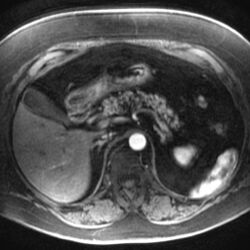Pancreatic steatosis
Pancreatic steatosis is an accumulation of fats in the pancreas. It can be also called fatty pancreas or pancreatic lipomatosis. The most common causes are obesity and the metabolic syndrome. This disease can lead to acute pancreatitis, and its relation to the malignant pancreatic cancer is being studied. Pancreatic steatosis is easily detectable by non-invasive imaging methods.
Etiology[edit | edit source]
Several different factors play a role in the etiology of pancreatic steatosis. Obesity is strongly associated with pancreatic steatosis. Some hereditary disorders may be associated with pancreatic steatosis either directly (for example Shwachman-Diamond syndrome) or due to progression of pathological alteration (for example cystic fibrosis). Hemochromatosis leads to the progressive damage of the exocrine part of the pancreas and replacement of the pancreatic parenchyma by the fibrotic and adipose tissue. Exposure to toxic substances and drugs can lead to steatosis, however this effect has only been determined for a few drugs (gemcitabine, rosiglitazone). Pancreatic steatosis can also be seen in patients with Kwashiorkor and AIDS.
Symptomatology[edit | edit source]
Accumulation of the small amount of fats in the pancreatic parenchyma is considered normal as it's not associated with any clinical manifestations. Pancreatic steatosis is associated with the following conditions:
- Metabolic syndrome,
- Type 2 diabetes mellitus,
- exocrine pancreatic insufficiency,
- acute pancreatitis,
- pancreatic cancer,
- pancreatic fistula.
Pancreatic steatosis is a relatively common accidental finding in autopsies or radiological examinations.
Histological findings[edit | edit source]
The multiplication of the adipocytes is often seen in pancreatic tissue. Fat accumulation is detectable by using immunochemical methods or electron microscopy even within acinar and insular cells. Damage to the epithelium precedes fat accumulation in adipocytes. There are conflicting findings regarding leukocyte infiltration.
Imaging techniques[edit | edit source]
On sonographic examination, the steatotic pancreas is hyperechogenic (compared to the liver or kidneys). Limited possibility of investigation, especially in obese patients, and the identical findings in many other disorders, show that ultrasound is not very sensitive or specific for the diagnosis of steatosis..
On CT scan images the pancreas appears as a hypodense structure. Fully developed steatosis has the same density as the adipose tissue. The decrease in density correlates with steatosis extent.
MRI is able to identify adipose tissue, especially with application of the special techniques. Magnetic resonance spectroscopy enables the quantification of the ectopic triglycerides.
References[edit | edit source]
Related Articles[edit | edit source]
Sources[edit | edit source]
- SMITS, M.M. – VAN GEENEN, E.J.. The clinical significance of pancreatic steatosis. Nat Rev Gastroenterol Hepatol. 2011, vol. 8, no. 3, p. 169-77, ISSN 1759-5053.
- BLAHO, Martin – DÍTĚ, Petr – KUNOVSKÝ, Lumír. Steatóza slinivky břišní: klinický význam. Vnitřní lékařství [online]. 2018, y. 64, no. 10, p. 949-952, Available from <https://www.prolekare.cz/casopisy/vnitrni-lekarstvi/2018-10/steatoza-slinivky-brisni-klinicky-vyznam-106725>. ISSN 1803-6597.

